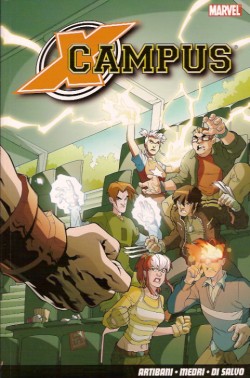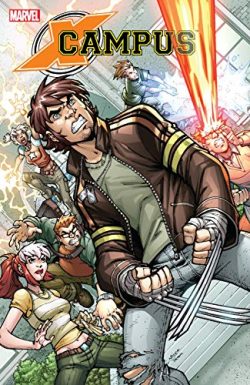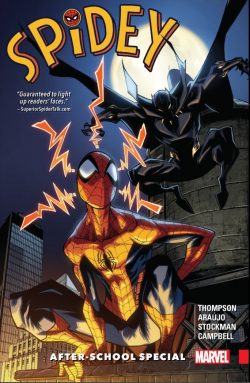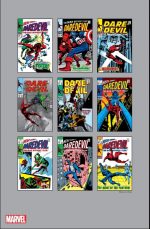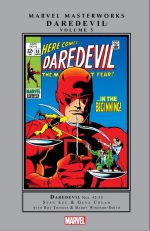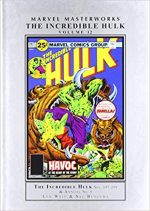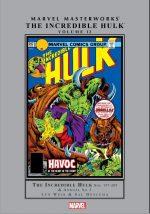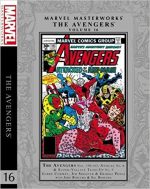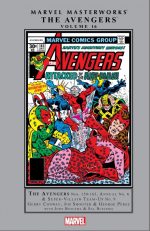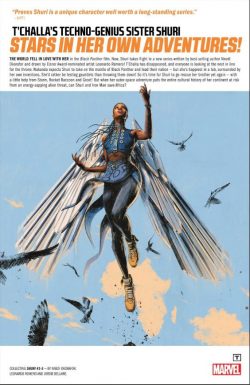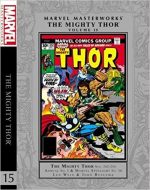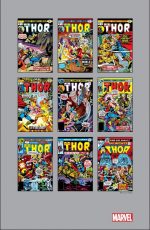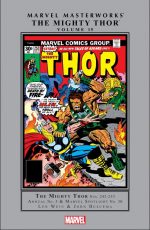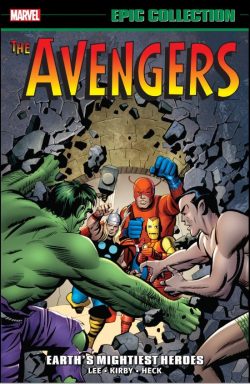
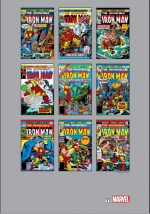
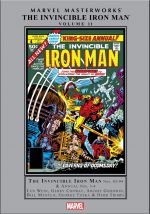
By Len Wein, Bill Mantlo, Archie Goodwin, Gerry Conway, Roger Slifer, Jim Shooter, Herb Trimpe, Steve Gerber, Roger Stern, George Tuska, Sal Buscema, Jeff Aclin & various (Marvel)
ISBN: 978-1-3029-1090-7(HB)
Arch-technocrat and supreme survivor Tony Stark has changed his profile many times since his debut in Tales of Suspense #39 (March 1963) when, whilst a VIP visitor in Vietnam observing the efficacy of the munitions he had designed, the inventor was critically wounded and captured by sinister, savage Communists.
Put to work building weapons with the dubious promise of medical assistance on completion, Stark instead created the first of many technologically augmented suits to keep himself alive and deliver him from his oppressors. From there it was a simple – transistor-powered – jump to full time superheroics as a modern Knight in Shining Armour…
First conceived in the wake of the Cuban Missile Crisis at a time when Western economies were booming and “Commie-bashing†was an American national obsession, the emergence of a new and shining young Thomas Edison, using Yankee ingenuity, wealth and invention to safeguard the Land of the Free and better the World, seemed an obvious development. Combining the then-sacrosanct faith that technology and business in unison could solve any problem, with the universal imagery of noble knights battling evil, Stark – the Invincible Iron Man – seemed an infallibly successful proposition.
Of course, whilst he was the acceptable face of 1960s Capitalism – a glamorous millionaire industrialist/scientist and a benevolent all-conquering hero when clad in the super-scientific armour of his alter-ego – the turbulent tone of the 1970s soon relegated his suave, “can-do†image to the dustbin of history.
With ecological disaster and social catastrophe from the myriad abuses of big business the new zeitgeists of the young, the Golden Avenger and Stark International were soon confronting a few tricky questions from the increasingly politically savvy readership.
With glamour, money and fancy gadgetry not quite so cool anymore the questing voices of a new generation of writers began posing uncomfortable questions in the pages of a series that was once the bastion of militarised America …
This grand and gleaming chronological compendium – available in hardback and digital editions – completes that transitional period; reprinting Iron Man #82-94 (January 1976 – January 1977) plus Annuals #3 and 4: aided and abetted by an informative and insightful measure of historical context courtesy of historian and author Bruce Canwell in his Introduction.
With an extended epic spanning the world and alternate dimensions finally completed long-term writer Mike Friedrich moved on, and Iron Man #82 welcomed a new era and tone as Len Wein, Herb Trimpe, Marie Severin & Jack Abel revamped the armour just in time for the Red Ghost and his super simians to kidnap super genius Stark in ‘Plunder of the Apes!’
Debuting in that issue was NYPD detective Michael O’Brien, who holds Tony responsible and accountable for the tragic death of his brother Kevin. The deceased researcher had been Stark’s confidante until his mind snapped. He had died running amok whilst wearing a prototype suit of Guardsman armour. Here and now Mike smells a cover-up…
IM #83 reveals ‘The Rage of the Red Ghost!’ (inked by Marie Severin) as the deranged Russian forces Stark to cure his gradual dispersal into component atoms, only to realise, following a bombastic battle, that the inventor has outwitted him once again, after which Wein, Roger Slifer, Trimpe & John Tartaglione detail how the infamous Enervator again turns a grievously injured Happy Hogan into a mindless monster. This time, the medical miracle machine saturates him with so much Cobalt radiation that he becomes a ticking inhuman nuke on the ‘Night of the Walking Bomb!’
The tense tick-tock to doom is narrowly and spectacularly stopped in ‘…And the Freak Shall Inherit the Earth!’ (Slifer w/Wein, Trimpe, Severin) after which Bill Mantlo, George Tuska & Vince Colletta revive and revamp one of the Golden Avenger’s oldest and least-remembered rogues when disgraced thermal technologist Gregor Shapanka sheds his loser status as Jack Frost to attack Stark International in a deadly new guise in # 86’s ‘The Gentleman’s Name is Blizzard!’
Despite his improved image, the sub-zero zealot can’t quite close ‘The Icy Hand of Death!’, leading to the first of this cracking chronicle’s mid-year spectaculars as Iron Man Annual #3 (June 1976) unveils ‘More or Less… the Return of the Molecule Man!’ courtesy of Steve Gerber, Sal Buscema & Abel.
Whilst Tony Stark looks into redeveloping some soggy Florida real estate, a little local girl finds a strange wand and is possessed and transformed by the consciousness of one of the most powerful creatures in existence…
Although Iron Man is helpless to combat the reality-warping attacks of the combination petulant girl/narcissistic maniac, luckily for the universe, the shambling elemental shocker dubbed Man-Thing had no mind to mess with or conscience to trouble…
Iron Man #88 signals the too-brief reunion of veteran scribe Archie Goodwin with George Tuska as ‘Fear Wears Two Faces!’ finds the Armoured Avenger battling escaped aliens the Blood Brothers after the vicious space thugs are psychically summoned to a mystery rendezvous with another old enemy of Iron Man. Inked by Colletta, the tale concludes in ‘Brute Fury!’ as Daredevil deals himself in to the cataclysmic clash and just barely tips the scales…
The hidden manipulator is exposed in #90 (By Jim Shooter, Tuska & Abel) ‘When Calls the Controller!’, as the life-force thief seeks to escape months of entombment by enslaving and feeding off hapless down-&-outs. His rapid defeat is only a prelude to greater catastrophe as Gerry Conway scripts and Bob Layton inks #91’s ‘Breakout!’ wherein the fiend tries too hard, too fast and again fades into helpless captivity…
The manic Melter soon regrets his ill-advised grudge rematch in ‘Burn, Hero… Burn!’ (Conway, Tuska & Abel) before Herb Trimpe returns as plotter and penciller in Iron Man #93, pitting Old Shellhead against a British-based modern-day pirate in ‘Kraken Kills’ (Conway Script & Abel inks), with the self-declared Commander deducing Stark’s secret identity before blackmailing the inventor into building weapons for his super-submarine fleet. Never at a loss, Stark turns the tables, sparking ‘Frenzy at Fifty Fathoms!’ to scupper the madman’s plans…
This bombastic book concludes with Invincible Iron Man Annual #4 (August 1977) and an all-action alliance with newly constituted super-team The Champions by Mantlo, Tuska & inker Don Perlin. When psychic assassin M.O.D.O.K. overwhelms the Golden Avenger, Iron Man calls in old allies Black Widow and Hercules (plus teammates Ghost Rider, Iceman, Darkstar and the Angel) to thwart ‘The Doomsday Connection!’
Also from that issue comes an out-of-place martial arts vignette by Roger Stern, Jeff Aclin & Don Newton. ‘Death Lair!’ stars former Master of Kung Fu villain Midnight on a mission of murder against old Iron Man enemy Half-Face…
Closing the covers on this stellar compilation are a selection of house ads and a short cover gallery of original art by Gil Kane, Esposito, Ed Hannigan & Frank Giacoia.
From our distant vantage point the polemical energy and impact might be dissipated, but the sheer quality of the comics and the cool thrill of the eternal aspiration of man in perfect partnership with magic metal remains.
These Fights ‘n’ Tights classics are amongst the most underrated but impressive tales of the period and are well worth your time, consideration and cold hard cash…
© 1976, 1977, 2018 Marvel Characters, Inc. All rights reserved.

